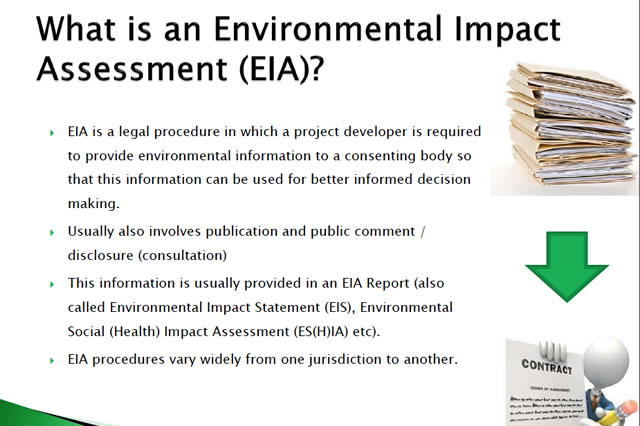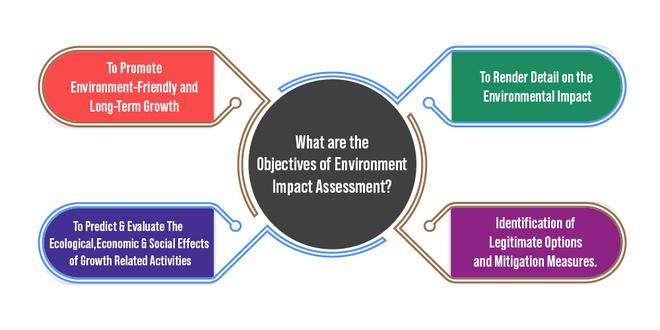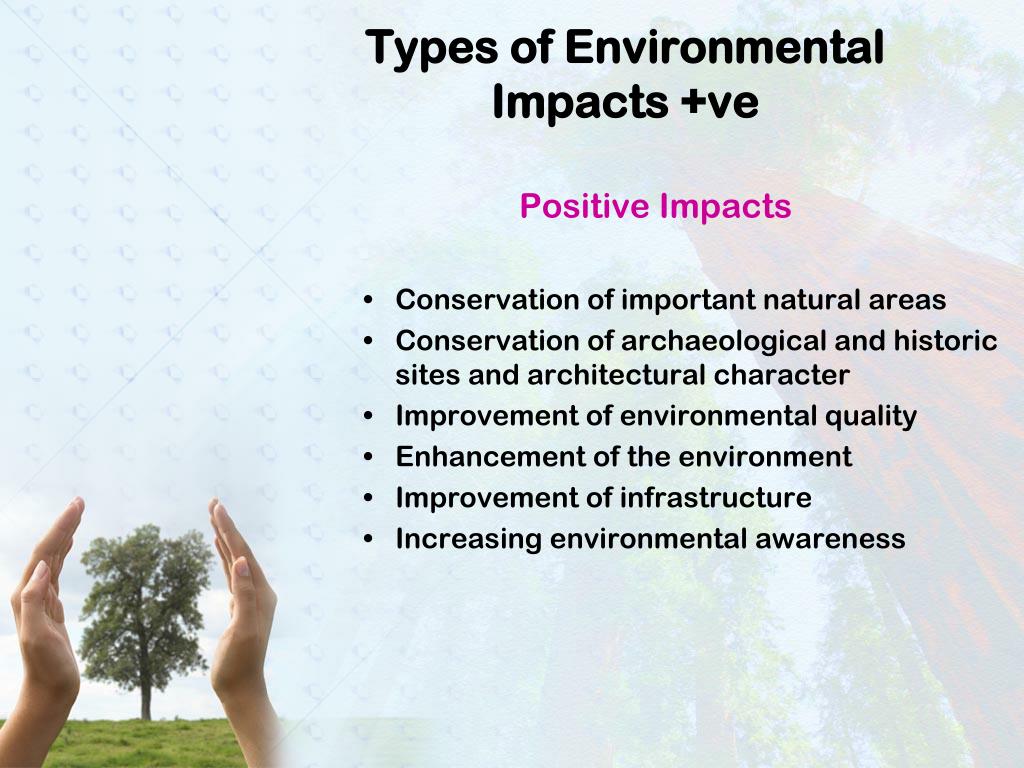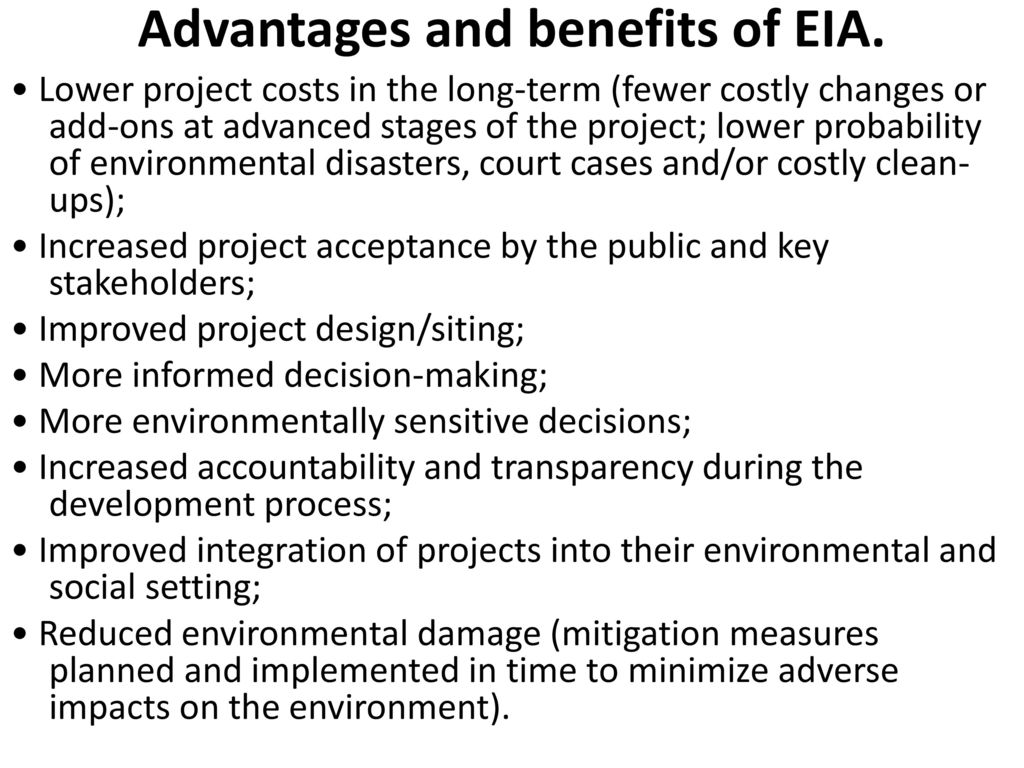Understanding Environmental Impact Assessment (EIA): A Key Tool for Sustainable Development
We hear a lot about protecting the environment, but what does that actually look like in practice, especially when new buildings, roads, or factories are being planned? That's where Environmental Impact Analysis (EIA) comes in. Think of it as a crucial check-up for our planet before any major development goes ahead. In this blog post, we’ll break down the concept of EIA, its importance, and how it helps safeguard our environment while promoting responsible growth.
Imagine you're planning a big party. You'd probably think
about how many guests you can fit, where they'll park, and if the music will
bother your neighbors. EIA is a similar process, but instead of a party, it's
about a proposed project, and instead of neighbors, it's about the environment.
Environmental Impact Assessment (EIA) is a process of evaluating the likely environmental impacts of a proposed project or development, considering interrelated socio-economic, cultural, and human health impacts, both beneficial and adverse" (International Association for Impact Assessment, 1999).
It aims to predict and minimize negative impacts while
enhancing positive effects on the environment and society. By identifying risks
early, EIA helps decision-makers and stakeholders make informed choices that
align with sustainability goals.
Simply put, EIA is a way to look closely at how a proposed
project might affect the environment – the air we breathe, the water we drink,
the plants and animals around us, and even our health and communities. It helps
us understand the potential good and bad consequences before decisions
are made.
Why is EIA Important?
Without EIA, projects could be approved without fully understanding the potential damage they might cause. This could lead to:
- Pollution:
Contaminating our air, water, and soil.
- Loss
of nature: Destroying habitats for wildlife.
- Health
problems: Impacting people's well-being.
- Wasted
resources: Not using land and resources sustainably.
EIA acts as a safeguard, ensuring that environmental factors
are considered alongside economic and social needs. It helps us make smarter
choices for a healthier planet and a better future.
Who Conducts EIAs?
Usually, the company or organization proposing the project
is responsible for conducting the EIA. However, governments and regulatory
bodies often set the rules and oversee the process to ensure it's thorough and
unbiased. Experts in various fields, like ecology, hydrology, and social
science, are often involved in gathering information and assessing the
potential impacts. Some NGOs participate
in reviewing or monitoring EIA processes to ensure transparency and
sustainability.
The EIA Process: Step-by-Step
While the details can get a bit technical, the general process of an EIA follows these key steps:
- Screening:
Is an EIA Needed? First, authorities decide if a full EIA is even
necessary. Smaller projects with minimal potential impact might be exempt,
while large-scale developments like building a dam or a major highway
almost always require one.
- Scoping:
What are the Key Concerns? This step involves identifying the most
important environmental issues that need to be studied. This might involve
looking at things like water resources, endangered species, or air quality
in the project area. This includes
determining the potential impacts on air, water, soil, biodiversity, and
human communities.
- Impact
Assessment: What Could Happen? This is the heart of the EIA. Experts
analyze the potential positive and negative effects of the project on the
environment. They might use scientific studies, models, and historical
data to predict what could happen if the project goes ahead. They also
consider different ways the project could be done (alternatives) and how
to minimize harm.
- Public
Participation: Who should be involved? EIA encourages public involvement
to ensure that community concerns and knowledge are considered. Public
hearings and consultations allow affected groups to voice their opinions
and contribute to the decision-making process.
- Mitigation:
How Can We Reduce Harm? Once the potential negative impacts are
identified, the EIA proposes ways to avoid, reduce, or even fix those
problems. This could involve things like installing pollution control
equipment, creating new habitats for displaced wildlife, or restoring damaged
areas.
- Reporting:
Sharing the Findings. The results of the EIA are compiled into a detailed
report called an Environmental Impact Statement (EIS) or similar document.
This report outlines the potential impacts, the proposed mitigation
measures, and the alternatives considered.
It should be evaluated on whether the project meets environmental
standards and whether the proposed mitigation measures are adequate.
- Review
and Decision-Making: Should the Project Go Ahead? The EIS is then reviewed
by government agencies, the public, and other stakeholders. They provide
feedback, raise concerns, and ask questions. Ultimately, decision-makers
weigh the environmental impacts alongside the economic and social benefits
before deciding whether to approve the project, potentially with
conditions.
- Monitoring:
Keeping an Eye on Things. Even after a project is approved, monitoring
might be required to ensure that the mitigation measures are working and
to identify any unexpected environmental problems that might arise.
EIA is used to assess and mitigate various types of
environmental impacts. These impacts can be categorized into the following
major areas:
- Air
Quality Impacts:
- Industrial
emissions, vehicle pollution, and deforestation can degrade air quality.
- EIAs
help in identifying pollution control measures, such as emission
standards and green buffers.
- Water
Pollution and Resource Management:
- Projects
like mining, agriculture, and industrial operations can lead to
contamination of water bodies.
- EIAs
recommend strategies such as wastewater treatment, sustainable water use,
and pollution prevention.
- Soil
Degradation and Land Use Changes:
- Construction,
deforestation, and agriculture can lead to soil erosion and loss of
arable land.
- EIA
suggests soil conservation measures, sustainable land-use planning, and
reforestation efforts.
- Biodiversity
Loss and Habitat Destruction:
- Infrastructure
projects, logging, and urban expansion can disrupt ecosystems and
endanger wildlife.
- EIAs
emphasize conservation plans, protected areas, and wildlife corridors to
minimize habitat destruction.
- Climate
Change and Greenhouse Gas Emissions:
- Industrialization
and deforestation contribute to global warming.
- EIAs
support renewable energy integration, carbon offset programs, and
sustainable transportation strategies.
- Noise
Pollution:
- Urbanization,
highways, and industrial facilities generate excessive noise pollution.
- EIAs
suggest mitigation strategies such as sound barriers, buffer zones, and
zoning regulations.
- Social
and Cultural Impacts:
- Displacement
of communities, loss of cultural heritage, and changes in local
livelihoods can occur due to large projects.
- EIAs
recommend compensation policies, community engagement, and cultural
preservation strategies.
- Health
and Safety Risks:
- Exposure
to hazardous materials, air and water contamination, and workplace safety
issues can affect local populations.
- EIAs
include risk assessments and strategies to mitigate health hazards.
The Benefits of EIA: Why Bother?
While it might seem like extra paperwork, EIA offers
significant benefits:
- Protecting
the Environment: By identifying and mitigating risks early, it helps
prevent irreversible damage to our natural world. For example, the EIA for the Amazon
Hydroelectric Project in Brazil helped prevent deforestation by
implementing sustainable land-use strategies.
- Promoting
Sustainable Development: It encourages projects that are environmentally
sound and consider long-term impacts.
For example, Canada’s EIA process for offshore drilling projects
has led to stricter regulations to protect marine life.
- Improving
Decision-Making: It provides decision-makers with the information they
need to make informed choices that balance different needs. In the case of the London Crossrail
project, EIA helped reduce disruptions to local wildlife and communities
through better route planning.
- Saving
Costs: By identifying potential problems early, EIA can prevent costly
mistakes and cleanup efforts down the line. For instance, the integration of EIA in
urban planning in Singapore has resulted in cost-effective, eco-friendly
infrastructure development.
- Encouraging
Public Participation: It gives communities a voice in the development
process and allows them to raise concerns.
In India’s POSCO steel plant project, public opposition highlighted
environmental risks, leading to a reassessment of the project.
While EIA is a valuable tool, it faces several challenges:
- Lack
of Enforcement: In some regions, weak regulations lead to ineffective
implementation. Even when EIAs identify potential risks, poor enforcement
of mitigation measures can result in environmental degradation. For
example, some mining projects continue to cause deforestation and water
pollution despite undergoing EIA due to regulatory loopholes and lack of
oversight.
- Potential
Biases: Developers may influence assessments to favor project approval. Consultants may downplay potential
negative impacts to secure project approval, undermining the integrity of
the process. This issue is particularly evident in industries such as oil
extraction, where economic interests sometimes overshadow environmental
concerns.
- Time
and Cost Constraints: Conducting thorough EIAs can be expensive and
time-consuming, leading some projects to cut corners. In developing countries, financial
constraints may limit the capacity to conduct comprehensive assessments,
resulting in incomplete or inadequate EIAs that fail to address critical
environmental risks.
- Balancing
Economic and Environmental Priorities: In some cases, economic interests
may outweigh environmental concerns, leading to suboptimal decisions. Governments often face pressure to
approve projects that promise economic growth, even when they pose
significant environmental risks. For instance, large infrastructure
projects such as highways and dams may receive approval despite EIA
warnings, leading to habitat destruction and displacement of communities.
This conflict between economic interests and environmental protection
remains a significant challenge in many parts of the world.
Best Practices for an Effective EIA
To enhance the effectiveness of EIA, the following best
practices should be adopted:
- Ensure
Transparency and Public Engagement: Stakeholder involvement strengthens
the credibility and fairness of the assessment. Research by the United Nations
Environment Programme (UNEP) highlights that public participation leads to
better environmental outcomes and greater community acceptance of
projects. EIAs should be embedded
in national environmental policies and strategic planning processes to
ensure they are not treated as an afterthought. The European Union's
Strategic Environmental Assessment (SEA) framework serves as a strong
example of how EIAs can be systematically integrated into broader
sustainability policies.
- Use
Scientific and Data-Driven Approaches: Relying on accurate, evidence-based
assessments improves decision-making.
Studies from the International Association for Impact Assessment
(IAIA) emphasize that using advanced modeling techniques and remote
sensing data enhances the reliability of EIAs.
- Implement
Effective Mitigation Strategies: Addressing potential impacts with
practical solutions ensures sustainability. For example, EIAs for wind farms in
Europe have incorporated bird migration studies to position turbines in a
way that minimizes harm to wildlife.
- Continuous
Monitoring and Adaptive Management: Regular evaluations ensure compliance
and allow for adjustments when necessary.
A World Bank report found that EIAs linked to ongoing monitoring
programs in hydropower projects helped reduce deforestation rates and
water contamination risks significantly. Research in developing countries
has shown that building local expertise improves the quality and
enforcement of EIAs.
Case Studies and Real-World Examples
The Three Gorges Dam – A Success Story in
Environmental Management
The Three Gorges Dam, located on the Yangtze River in China, is one of the world's largest hydroelectric projects. It has played a crucial role in flood control, power generation, and economic development. However, due to its massive scale, the project also posed significant environmental and social challenges, making it an essential case study in Environmental Impact Assessment (EIA).
The Role of EIA in the Three Gorges Dam Project
Before construction began in 1994, an extensive EIA was
conducted to evaluate the potential environmental, ecological, and social
impacts. The key areas of focus included:
- Water
Quality and Ecosystem Impact:
- The
EIA identified risks such as sedimentation, changes in water temperature,
and disruption of aquatic life.
- Mitigation
measures included water management systems to control pollution and
strategies to protect endangered species, such as the Chinese river
dolphin.
- Resettlement
and Social Impact:
- The
dam's construction required the relocation of over 1.3 million people.
- The
EIA recommended compensation programs, new housing projects, and economic
opportunities for displaced communities.
- Landslide
and Seismic Risks:
- Geological
assessments highlighted the potential for landslides due to reservoir
water pressure.
- Engineering
modifications were introduced to reinforce dam stability and implement
early-warning systems.
- Climate
and Carbon Emission Reductions:
- The
EIA also emphasized the project's role in reducing reliance on coal-fired
power plants, contributing to China's carbon reduction goals.
- Since
its completion, the dam has significantly cut greenhouse gas emissions by
replacing fossil fuel-based energy sources.
Success Factors and Lessons Learned
- Proactive
Environmental Management: The EIA led to ongoing environmental monitoring
programs that helped mitigate negative impacts over time.
- Adaptive
Policy Adjustments: Continuous assessment allowed policymakers to modify
resettlement strategies and environmental conservation efforts.
- Infrastructure
Resilience: The project has successfully controlled flooding along the
Yangtze River, benefiting millions of residents.
Despite criticisms regarding biodiversity loss and social
displacement, the Three Gorges Dam serves as an example of how comprehensive
EIA processes can guide large-scale infrastructure projects toward more
sustainable outcomes.
The Deepwater Horizon Oil Spill – A Case of Inadequate EIA
The 2010 Deepwater Horizon oil spill in the Gulf of Mexico remains one of the worst environmental disasters in history. A flawed EIA process played a major role in the catastrophe.
- Insufficient
Risk Assessment: The EIA for the BP-operated drilling project
underestimated the potential consequences of an oil spill. The risk
analysis failed to consider worst-case scenarios, leading to inadequate
response planning.
- Weak
Regulatory Oversight: Regulatory bodies approved the project despite
concerns about the reliability of blowout preventers, the key safety
mechanism meant to prevent uncontrolled oil discharge.
- Environmental and Economic Damage: The spill released over 4 million barrels of oil into the ocean, devastating marine life, coastal ecosystems, and local fishing industries. The EIA failed to anticipate and plan for the long-term consequences of such a disaster.
In the aftermath, stricter offshore drilling regulations were introduced, and EIA processes were strengthened to incorporate more rigorous risk assessments and emergency response plans.
Conclusion
Environmental Impact Assessment (EIA) is an essential tool
in promoting sustainable development. By integrating environmental
considerations into project planning, EIA helps prevent ecological damage while
ensuring economic progress. While challenges exist, best practices such as
transparency, scientific rigor, and public involvement can enhance its
effectiveness. As we move towards a greener future, embracing robust EIA
processes will be crucial in balancing development and environmental
responsibility.











Comments
Post a Comment